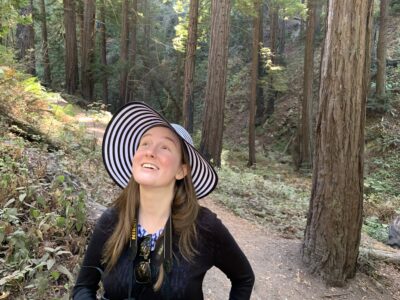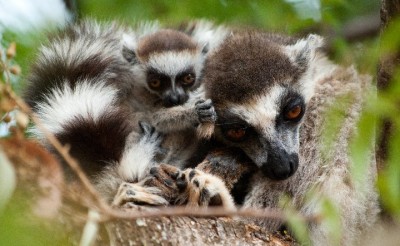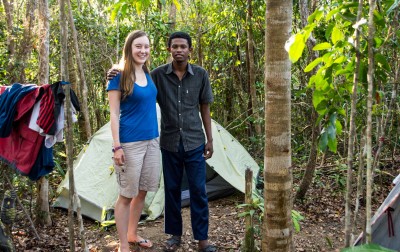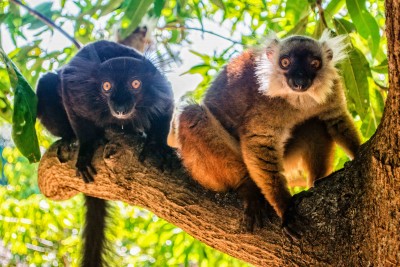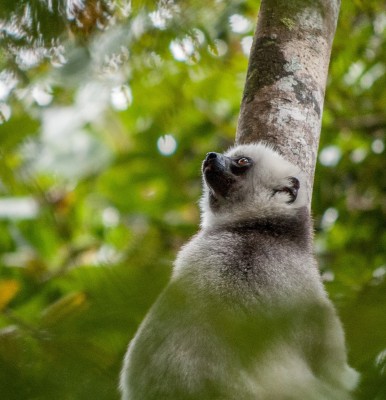Jen is passionate about Madagascar because it’s simultaneously one of the most biodiverse and threatened places on earth. Helping lemurs and their habitat seems like some of the biggest conservation bang you can get for your buck! Learn more about Jen and contact her at jentinsman.com.
When did you first get interested in working with lemurs and conservation and what motivated you to undertake this work?
I stumbled into lemur research by accident. I’d gotten a grant from the Biology Department to study social behavior and I was supposed to do research on tree swallows but that opportunity fell through, so I was nervously drifting around the department, trying to come up with a new project. Then Alison Jolly came and gave a talk to the Behavioral Ecology seminar I was enrolled in about her research on ring-tailed lemurs.
At one point in Alison Jolly’s lecture, she said she was always interested in helping students do research at Berenty Reserve. I raised my hand and said, “I’d like to go!” before I knew what I was doing. And you know, she was generous enough to take me seriously and encourage me.
We chatted after class about possible research topics, and I bought a plane ticket to Madagascar the next week.
My interest in conservation stems from two things: working in Madagascar and my feminism. It’s impossible to study lemurs and not be confronted with the myriad ways humans alter their habitats. Madagascar’s remaining forest is highly fragmented, and this means that people and the forest are in very close contact, and that their fates are inextricably intertwined.
Women are more dependent on the environment than men on average, and are more likely to face negative consequences from climate change. Empowering women by giving them access to basic needs, like education and family planning resources, puts them in a better position to manage their natural resources sustainably. Conserving the forest means it’ll still be there for their daughters. Working in Madagascar makes it easy to see that if you care about the forest, you must care about women, and vice versa.
What projects are you currently working on that relate to lemur or environmental conservation?
My current research focuses on two species of lemur in northwestern Madagascar – the blue-eyed black lemur (Eulemur flavifrons) and the black lemur (Eulemur macaco). They’re very closely related, but flavifrons occupies a much hotter, drier habitat than macaco.
People typically associate arctic places and polar bears with the negative consequences of climate change, and that’s very true, so it might be a surprise to think about climate change in the tropics. However, tropical species are adapted to a narrower range of conditions than species occurring in more seasonal latitudes, and they might have less flexibility to respond to the changes in temperature and rainfall that are predicted for the future. In fact, many lemur species are expected to undergo severe range contractions and a few are even expected to go extinct just because of climate change.
So what I’m trying to figure out is how, at a genomic level, did Eulemur flavifrons adapt to its current niche? What genes are involved in tolerating hotter, drier conditions, and does adapting to these more extreme conditions mean a loss of genetic diversity?
The way I’m going to answer these questions is by comparing allelic variation from all across the genome to detailed maps of temperature and precipitation variation, and see if any genes really closely match the climate variables. I’m also going to be assessing genetic diversity more generally, since both of these species are threatened with extinction. E. macaco is currently listed as Vulnerable by the IUCN, and E. flavifrons is considered one of the 25 most endangered primates in the world.
What’s your favorite thing about working in Madagascar?
My favorite thing about working in Madagascar, other than my excellent collaborators, is this frisson of joy I still get when I see my first lemur at a new field site. The only feeling I can really compare it to was when my mom told me that for my sixth birthday, I could rescue a cat.
Brown lemurs are so full of ornery and delightful life, with their piggy noises and their curiosity. Sometimes when we catch up with an unhabituated group that’s experienced hunting pressures, they’re wary of us, so they oink and wag their tails like angry little metronomes to scare us off. Other groups though might have some brave juveniles who leave the safety of the sleeping, giant poof ball of lemurs to conduct their own observations. I love their personalities.
My other favorite thing about working in Madagascar is collaborating with Malagasy scientists and conservationists. MICET and the Bioanthropology Department make it really easy to get paired up with a student from the University in Tana, which is how I met my Eulemur macaco collaborator, Jocelyn Ralainirina.
This trip would have been not only unsuccessful, but impossible without his good ideas, field skills, and patient translation. I also met two heroes, Desiré Rabary and Jackson, when I visited the Duke SAVA Conservation Project. They’re both park guides for Marojejy National Park who were inspired to start their own reserves. I got to see the bamboo lemurs in Antanetiambo, Rabary’s reserve, which he’s studying. He’s also expanding and reforesting the reserve with Duke SAVA’s help, and is engaged in all sorts of community development, from a library to a fish pond that adds protein to people’s diets. As a Western scientist with research and conservation interests so far from home, I’m very, very lucky to get to work with these guys.
What is a typical day like for you? What is your day like when you’re working in the field?
Trying to sample the entirety (or as much of it as we can get to) of two species ranges means that we don’t stay in the same place for very long. A lot of days involved traveling. Sometimes we go by foot with porters, or up river by pirogue, across the ocean by speedboat, and once we rented an ox cart. When we’re at a field site, days consist of following a local guide who knows how to locate the lemurs.
If we’re lucky and we find them when they’re resting, we hunker down and wait for them to poop. This is my favorite part, because it usually means uninterrupted time for observing their behavior without having to collect data.
If we’re not lucky and we find an unhabituated group while they’re traveling, there’s a lot of running. I’m comically slower than my collaborator, Jocelyn. So it’s usually him scrambling through the brush after the lemurs and me scrambling after him. Once they poop, we locate the sample, which can be tricky in the leaf litter on the forest floor, and then put the poop in a tube of preservative that’ll keep the DNA intact until I get it to the lab. Then we take a GPS point, which is critical for the spatial analyses I’m planning.
What are the hardest parts about doing lemur-related work in Madagascar?
The hardest part of this field trip was walking two days, through unbearably hot mountains, to get to a place called Ambodivohangy. It wasn’t on any map we could find, but we went with an awesome guide named Tsimba from Malagasy National Parks.
I was so excited about this particular site because 30 years ago a team of researchers reported hybrid lemurs out there.
They didn’t do any genetic work, and as a geneticist I was stoked to have samples from there so I could test this hybrid question rigorously. People were extremely reticent to work with us, which was a first. It turned out that they were worried we might sanction and fine them – they’d been burning large swaths of Manongarivo Special Reserve to turn it into agricultural land.
Once we did find a local guide and get into the forest, Manongarivo held true to its name, which literally translates to “One Thousand Climbs.” The reserve isn’t open to tourists, so there aren’t amenities like paths, for example. It’s like brutal, real-life chutes and ladders. The forest was still and silent as the grave, except for the legions of terrestrial leeches.
The only evidence that lemurs had been in the park at all were traps set for them by the local people. We left without a single sighting, let alone genetic samples. Physically exhausting work is a part of research, but a place that is that sad and frustrating on top is really hard to bear.
What are the biggest threats facing lemurs in your line of work, and what needs to be done to alleviate those threats?
Habitat loss is the biggest threat facing species in Madagascar, period. AEECL is doing an amazing job protecting E. flavifrons’ habitat through their Sahamalaza programme. Fires are a huge problem in such a dry place, and AEECL has turned building a firebreak into a huge annual party for the local communities. They’re also engaged in providing education, healthcare, and a training and infrastructure to support ecotourism in the Sahamalaza peninsula. It’s brilliant work in response to such a complex situation.
While habitat loss is a massive issue, the lemurs I study are also really susceptible to hunting. I’ve seen more traps each month of this trip than I had in my entire career as a researcher before.
Enforcement of laws about hunting these species and clearly demarcated reserve boundaries would be good short term actions, but long term we need to provide communities with better sources of protein. Duke SAVA’s fish ponds are one really great solution, since people tend to prefer fish over wild meat.
What is the funniest or most memorable thing that has happened to you while working on lemur-related programs?
One morning early in my research at Berenty completely disillusioned me about the BBC-nature-documentary majesty of lemurs. I was doing a focal follow on one of the males in the troop, and all of a sudden, this earsplitting, unearthly sound I’ve never heard before rips through the forest.
The male I’m following picks it up. He opens his mouth, and this mix between a human baby and a cat screaming, and a very angry tea kettle comes out. I get goosebumps. It’s not something I ever want to hear before falling asleep at night. The meaning of this call is very clear: DANGER, BEWARE!
So I look around, because there are two things that make lemurs give this call: hawks and snakes. I am fine with hawks, but you know, I’m not exactly interested in stepping on a boa. I see nothing, just some sifaka and a lost goat. I walk a little farther, very careful of where I’m stepping, and keep searching. The goat bleats, and that noise of horror and utter fear rips through the lemur troop again. The morning goes on like this: Bleat. SCREAM. Bleat. SCREAM. Bleat. SCREAM. The sifaka are freaked out too, and muttering like angry old men about it. So yes, lemurs are primates and highly intelligent, but they are also ridiculous creatures.
In ten years, what do you hope to have accomplished in terms of your work in lemur conservation?
In ten years, I’d love to have made myself completely redundant by training Malagasy scientists in genomic techniques. Supporting Malagasy scientists is a home run for conservation because they know lemurs and the local people better than Western researchers ever can.
I want to be a part of offering them more training and opportunities for international collaboration. I’m especially interested in encouraging Malagasy women in conservation science, because I think they might be able to connect with women in the communities they work in in a different way than male scientists do. And because female scientists are awesome.
How can people across the world help save lemurs and help your work?
Donate. There are so many amazing organizations working in communities in Madagascar, and they need all the help they can get.
Take Action
- Jen recommends supporting the AAECL and Duke’s SAVA Conservation Initiative!
- Jen also worked with MICET (associated with Centre ValBio) and students from the University of Antananarivo!
- Learn about the blue-eyed black lemur in this podcast with Jen

